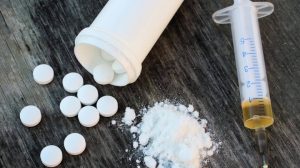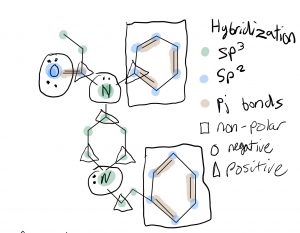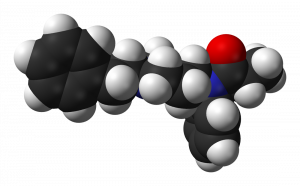The chemical formula of f entanyl is C22H28N2O. Fentanyl is made synthetically from the opium poppy. It was synthesized originally following a four-step process that included condensing N-benzyl-4-piperidone and reducing it with LAH, and the final step included performing the Finkelstein reaction.
entanyl is C22H28N2O. Fentanyl is made synthetically from the opium poppy. It was synthesized originally following a four-step process that included condensing N-benzyl-4-piperidone and reducing it with LAH, and the final step included performing the Finkelstein reaction.
The biggest area of negative charges are around the elements with lone pairs such as the oxygen and the nitrogen. The non-polar areas are the carbon rings because all carbons are surrounded by hydrogens. There is no area within fentanyl that has a positive charge. The strongest bonds are the oxygen to carbon and nitrogen to carbon do to the disparity of electronegativity. The second weakest bonds are the Carbon to Carbon because they have the same electronegativity.

The weakest bond is Hydrogen to Carbon. This will also affect the bond length. The stronger the pull between the atoms, the shorter the bondlength. This means the bonds between the Oxygen to carbon and Nitrogen to carbon are shorter, Vise versa for the Carbon to Carbon bonds. They are longer due to less attraction between atoms. This would also show that the Carbon to Hydrogen bond is the longest because it has the weakest bond.
Fentanyl is most commonly administered through a patch with a gel on it. It also can be given in the form of a lozenge and as a tab that goes under the tongue. On the streets it usually comes in a pill form and commonly mixed with other drugs.

Fentanyl binds to the opioid receptors in the brain and nervous system that control pain and emotion. This creates a state of euphoria and relaxation.
Fentanyl is transported by the P-glycoprotein 1 or multidrug resistant protein 1. It uses dipole-dipole bonds and hydrogen bonds to bind to the protein.

When Fentanyl arrives at the receptors it bonds at inhibits the regulator proteins that reduces the abundance of multiple neurotransmitters. This reaction simultaneously opens potassium channels and closes calcium channels, which creates a higher accessibility to more neurons.
Fentanyl stays in your urine for up to 3 days, as well as your blood for two days. However, hair follicles can hold fentanyl for up to three months. It does not matter on the dosage. The drug is renally excreted after it is turned into norfentanyl. It turns into C14H28N2O (norfentanyl) and C8H8 (styrene). If 1g of it breaks down it will create 0.69g of norfentanyl and .31g of styrene.Styrene is absorbed in your body and norfentanyl is excreted through urine.

